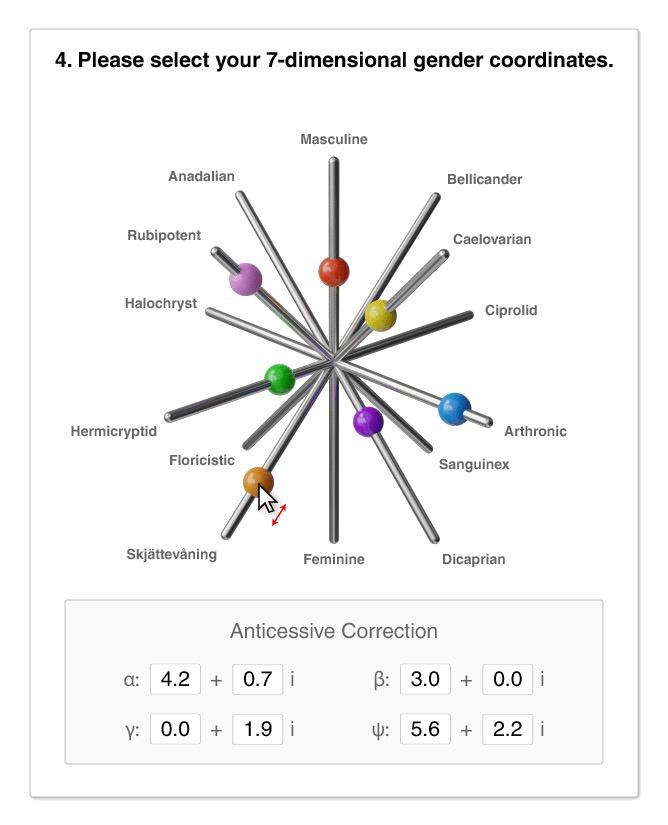- cross-posted to:
- programmer_humor@programming.dev
- cross-posted to:
- programmer_humor@programming.dev
Approximation is an important tool for compressing information into useable forms. All labels are limited approximations too. Such compression is inevitably lossy, but that is a sacrifice for the sake of practicality. The important question is what level of compression is acceptable for a given context. If I describe the location of a chess piece on the board, I don’t need to specify how far off-center on its square a given piece is, so a 0-7 offset along each of the two axes is enough for game purposes.
When it comes to gender, I think we all agree that [0, 1] is insufficient, but how do we determine what is sufficient? Do we argue that a 2-bit vector (masc, fem) is enough to describe {neither, fem, masc, both} for rough rounding, or do we need more detailed values along those axes, or perhaps a third axis too (or more)?
This is a very nice and effective blurb, I’m saving this comment for future use
There’s no awards/medals here but take this: 🥇
Honestly, “I found this useful/interesting/amusing/worth leaving a positive comment avout” is the only award I need. Thanks for the words of appreciation ❤️
Maybe a byte using bitflags?
Mine is #1B4D3E
Ayyyyy wanna smash bros?
I have PS2
My gender is e, which can be represented by neither integers nor floating points.
Can it be expressed or represented approximately in IEEE-754 form?
Always approximated, never truly represented 😞
No taxation without approximation!
Unless your encoding has a special value that, by definition, is euler’s constant :p
Good point. Specifically code point U+2107 https://en.wikipedia.org/wiki/ℇ
Ah so ur gender can be represented in UTF 8.
Everything can be represented approximatively.
e = π = 3
Obviously, there is True, False and FILE_NOT_FOUND
Better than having your gender datatype being a Bobool3ol and evaluating to “Tru(🍒🎂🍒)lse”.
There are
10kinds of people in this world. Those who understand binary and those who don’t.There are n types of people in this world: Those who don’t understand numeral systems, those who understand base x systems for x ∈ [2, n] and those who get pedantic about this meta-joke.
There are
10kinds of people in this world. Those who get ternary; those who don’t; those who thought this was going to be a binary jokeThere are
10kinds of people in this world. Those who get quaternary; those who don’t; those who thought this was going to be a ternary joke; those who can see where this is going…I might be a slow learner but I’m catching on…
Regardless of what base you’re using, 10 is always the nth number. In base 10 (normal numbers), 10 is 10th. In base 2 it is the 2nd.
- 1
- 10
- 11
In base 16 (hexadecimal) it is the 16th.
- 1
- 2
- 3
- 4
- 5
- 6
- 7
- 8
- 9
- A
- B
- C
- D
- E
- F
- 10
The original joke is “there are 10 kinds of people, those who understand binary and those who don’t l” because 10 in binary is 2 in base 10. But they’re pointing out that a similar joke works for all bases of numbers.
I love that you felt like this needed explaining - thanks!
Some of us would argue 10 is the n+1 th number because zero comes first. Otherwise you’re just throwing a new digit into the mix when you get to 10.
Zero comes zeroth.
ah I see, you are the 10th kind!
every base is base
10And what are the other e?
Choose one class of gender:
- Natural
- Rational
- Irrational
- Complex

this is p-adic gender erasure
That’s a very quaternionphobic list.
It is definitely complex numbers in polar form
Even if every single person in the world had a unique gender, you could store that in 33 bits
You can store that in a small QR code
Those bits wouldn’t really provide the information to construct that gender though.
Neither would if you stored it as a bit
Maybe it can be represented by 1qbit
literally discussed with my friends the other day that gender is like a vector in Hilbert space
I don’t think so, because with qubits the intermediate values can be non binary but the end result must be binary when read.
I’ve been thinking about this now and again. IMO gender, if one insists on tracking it at all (which I mostly find counterproductive), would need to be a vector / tuple of floating-point values. The components would be something like:
- Sexual Development Index: Encodes chromosomal sex, genitalia, and other primary sexual characteristics (X/Y chromosome ratio).
- Hormonal Balance & Secondary Sexual Characteristics: Combines hormonal levels and the resulting secondary traits (body hair, muscle mass, etc.).
- Brain Structure: A dimension indicating how a person’s brain structure aligns with typical male or female patterns.
- Gender Identity: A measure of self-identified gender, representing the psychological and social dimension.
- Fertility/Intersex Traits: A combined measure of fertility potential and the presence of intersex traits (e.g., ambiguous genitalia, mixed gonadal structures, etc.).
Ideally it would track the specific genes that code for all of the above factors, but unfortunately science hasn’t got those down yet.
Also genes is only half of it. Expression of genes is another, complicated story.
Gender Identity, now with linear algebra. Those 3b1b videos are going to be super useful, but not in the way the author intended.
A good way would be to create as many variables as possible that map anything relevant, genes, upbringing, sexual and gender expression, etc., and then doing a PCA to reduce the defining vector to as few elements as possible.
I like how you think but I’m not sure if that alone will hold water. A variable can vary wildly even though it’s not very relevant to the property you’re interested in, and PCA would consider such a variable to be very significant. Perhaps a neural network could find a latent space. But ideally we want the components to have some intuitive meaning for humans.
These are all measurable except 4
In how far does gender change in your hypothetical metric with transition. If I take hormones for example, I would influence this metric.
Another confusing point would be how you try tracking gender, but having a gender identity value inside the metric. How would you even track this gender then?
All of these are measurable. I’m not sure what’s the source of your confusion. Yes the terminology becomes a bit ambiguous unless we make up a new word/term for the tuple, but gender identity is just one dimension of it. It can be measured with a standardized questionnaire.
Gender is not a boolean value.
🚫
const gender👉
var genderkhm, khm
let genderplease don’t use deprecated syntax
But that’s immutable 🦀
May be gdscript
And liable to type conversion errors and precision loss.
Jesus, why’d you have to bring floating point and machine precision into the conversation? Now I won’t sleep. And the nightmares will be worse than before.
A boolean variable?
So many other things are also non-binary, but people insist that not being 100% on their side means you’re a million percent on the extreme opposite hateful wrong side.
Absolutely. My baseline is that I want everyone to be treated equally and with respect. I want everyone have the same protections from the government and everyone to be allowed to be and to love whoever they want.
Past that, it gets into minutia I just can’t get on board with and it’s hurting the left as a whole because people are trying to force language and thought policing on people, which I don’t like, it’s authoritarian, and I think it’s a losing strategy.
It’s been said that indecisiveness and perfectionism are liberal weaknesses, and decisiveness and being willing to ignore imperfections for the sake of the team are conservative strengths. I think Michael Moore put it best… Liberals say, “What should we do about dinner? I don’t know… do you want to go out? I dunno, do you? Well, if you do. Okay, where should we go? I dunno, where do you wanna go?” A conservative slams his hand on the table and says, “Get in the car, we’re goin’ to the Sizzler!”
A lot of the userbase here thinks this way and it’s very tiresome
mmm… a
long longlong long man: https://www.youtube.com/watch?v=6-1Ue0FFrHY










